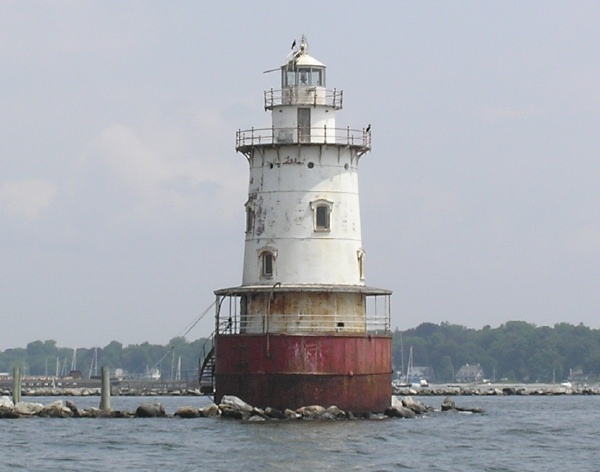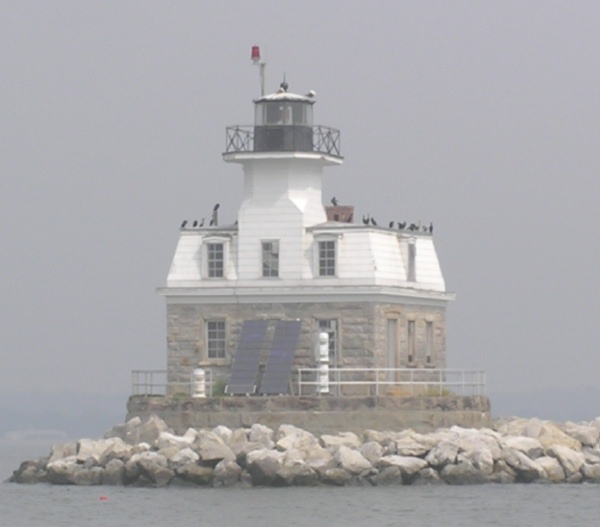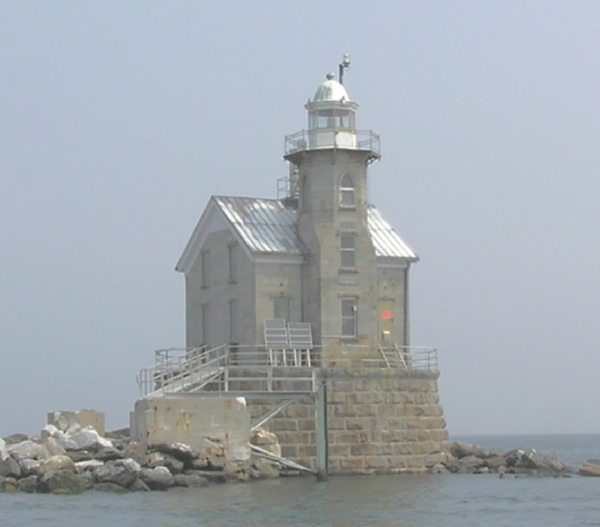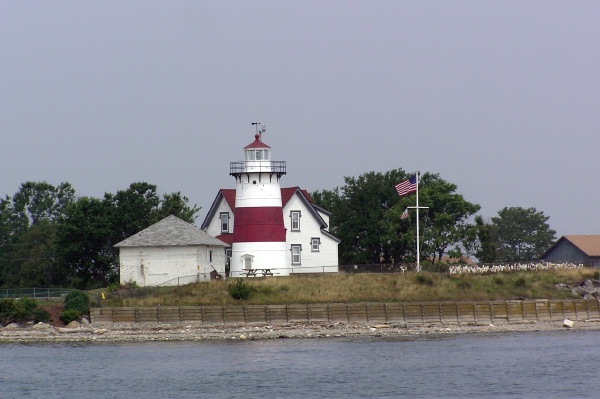The last light for the day (except for a faux light within the harbor) was Stamford Harbor Ledge (Chatham Rocks), CT. Built on Chatham Rocks, located about 2/3 of a mile offshore of Stamford Harbor, the 1881-built cast-iron tower set on top of a cylindrical cast-iron caisson, is similar to a number of other lighthouses in the region. The sections were made at a Boston foundry, brought to the site, and bolted together on site.
Considered especially cramped and uncomfortable, the structure was not a favorite of the keepers assigned there.
Sold to the city of Stamford in exchange for a promise to use it as a historical site for at least 20 years in 1953, the city failed to maintain the site and returned it to the government in 1961. It was sold to investors in 1967 for $10,000, changed hands numerous times and resold in 1984 for $230,000 to a banker who spent another $300,000 renovating it for use as a residence. The owner’s wife has an aversion to boats and wanted no part of the 15-minute journey to and from the island where the structure is located. The banker passed away in 1998 and the lighthouse, which had been placed on the real estate market in 1996 for $1.1 million, was taken off the market. It is believed to still be owned by his family. It is not open to the public and the best views are from the water.

We returned to Veterans Memorial Park at 3:30 and headed back to Kent–about 2 hours away. Sunday found us departing with 18 other passengers from Captain’s Cove Seaport in Bridgeport, CT at 10:30 AM.
First lighthouse for photographs was Penfield Reef Lighthouse, CT. Construction on this light began in March of 1871 on the snakelike promontory with a head of sawtooth rocks. Two hundred years ago the peninsula was once a lush pasture and supported sheep and a dairy herd. Because of this association the rocks are known locally as "cows" or "calves." After the cattle and sheep had stripped away the vegetation and ballast hunters carried away the protective riprap, the peninsula underwent geological changes. First it formed as an island, then a sand bar, and finally a reef.
Built at a cost of $55,000, the pier's center is filled with concrete above the base level of the riprap to allow for the addition of a basement and cisterns. The top of the pier, originally covered with granite slabs, is now surfaced with concrete.
The 35'-tall lighthouse shows the influence of Second Empire styling with its square plan, quoins, foot-scrolled window surrounds and mansard roof. The square dwelling's first story walls are brick faced with rough granite ashlar with slightly protruding corners (quoins). The base of the structure is outlined in larger granite blocks. The wood-framed second story is contained within the mansard roof. The square tower rises from the second deck and at the third level becomes a 4-sided structure with beveled corners.
When occupied, the first deck held a parlor, galley and supply room. The second deck contained 4 bedrooms and the third level was the watchroom. Although the structure's interior lacks any ornamental detailing, it contains a spiraling stairway that begins at the first floor entry and ascends as an oval to the third floor's watchroom.
The reef's first optic was a standard 4th-order Fresnel lens powered by a kerosene lamp. It was placed in operation on January 16, 1874. By 1899 the lantern had a 4th-order Fresnel bull’s-eye lens rotated by a weighted clockwork mechanism manufactured in the lighthouse service's Thompkinsville, NY depot. The Fresnel optic has been replaced by a modern 1,000-watt lens.
The light marks Penfield Reef which extends into Long Island Sound from Shoal Point. To complicate navigation, this light has often been mistaken for the Stratford Shoal beacon, located midway between Long Island and Connecticut. Problem is that while the Stratford Shoal Lighthouse can be passed on either side, the Penfield Reef Lighthouse is passed only on the Long Island side. This restricted passage and some really violent storms have caused a significant number of shipwrecks.
Not much work has been done to preserve this boarded-up lighthouse and no governmental or private organization has yet expressed any interest in preserving this historic structure which was recently offered for sale for $1.
Owned by the U.S. Coast Guard and listed in the National Register of Historic Places.

Next was Stratford Shoal Lighthouse, CT. Official maps place the lighthouse on the CT side of LI Sound by 1,000 feet, but it is frequently classified as a NY lighthouse. Early maps of LI Sound (1614) show 2 islands where the Stratford Shoal Lighthouse now stands. Since those maps were drawn, the sea has washed the islands off the map, leaving the dangerous Middleground Shoal measuring 3/4-mile long. The rocks were located roughly in the middle of LI Sound, 5.5 miles from Stratford Point, CT and 5 miles from Old Field Point, NY. Covered by less than 2' of water, the Shoal was a constant and dangerous threat to LI Sound ship traffic.
A lightship was placed at the southeastern edge of Stratford Shoal in 1838. Its single anchor was inadequate and after only 8 days of service, the ship drifted off position. Despite adding 2 larger anchors, the problem persisted for many years. During the winter of 1875, pack ice pushed the lightship aground at Orient Point. The ship was reported missing the following year and was finally found near Faulkner Island–over 20 miles away.
The Lighthouse Board recommended a lighthouse be built to replace the aging and troublesome lightship. Its foundation, built with huge undressed blocks of granite attached together with thick cast-iron stapes encased in lead, stands 19' tall. The interior of the foundation was filled with concrete, with a space left vacant for a brick-lined basement and 2 storage cisterns.
It’s nearly identical to the Race Rock, NY lighthouse, and is said to be haunted by the Second Assistant Keeper who committed suicide. Fully automated since 1970, much of its interior detailing has been taken out.

Next was Stratford Point Lighthouse, CT, originally a 28' tall wood-framed and shingled tower, erected in 1821 on the west side of the dangerous mouth of the Housatonic River. The station also included a small wooden keeper's dwelling. The revolving light consisted of 10 lamps and reflectors on two tables of 5 lamps each, 44' above the water which could be seen out to 12 nautical miles. In 1822 the tower was re-equipped with a Lewis 10-lamp Argand device that was given a flashing characteristic by a revolving clockwork-powered metal eclipser. The mechanism was manufactured by Simon Willard, a master clockmaker. During the mid-1850s the old tower received a 5th-order Fresnel lens. When the present brick lined tower was built in 1881, it was fitted with a Henri LePaute 3rd-order Fresnel lens and a kerosene-powered constant level lamp, both rotated by a clockwork mechanism. Stratford Point's tower consists of 5 rows of curved cast-iron plates bolted together though flanges cast at the plates' inner edges. Like that of Saybrook Breakwater, this unadorned tower's only feature of architectural interest is the conservative cast-iron styling of its molded windows surrounds, which are embellished with projecting shallow peaked lintels, recessed spandrels with cornices, and flanking consoles. In 1906 the lantern was equipped with a new 4th-order Fresnel lens that revolved in a trough of mercury. In 1932, the classical lens was re-equipped with an incandescent lamp. The tower's original lantern was removed in 1969 to facilitate the installation of oversized automated rotating aerobeacons. It was found, donated, and ceremoniously returned to the refurbished tower along with a modern lens on July 14, 1990.
The light station contains the 35' tall lighthouse, a 1½-story, wood-framed Gothic Revival keeper's dwelling built in 1881, and a brick fog signal building added in 1911. It is owned by the U.S. Coast Guard and manned by a Station (Coast Guard) Keeper. It is listed in the National Register of Historic Places.


